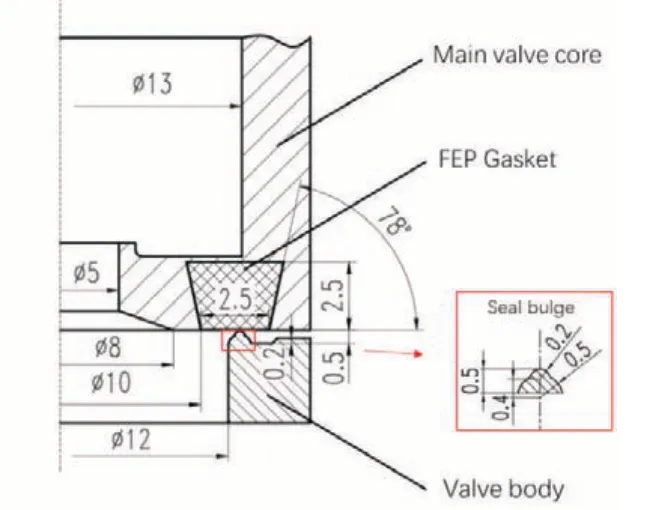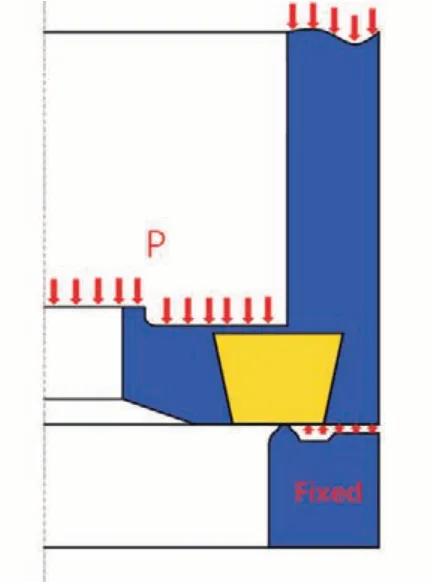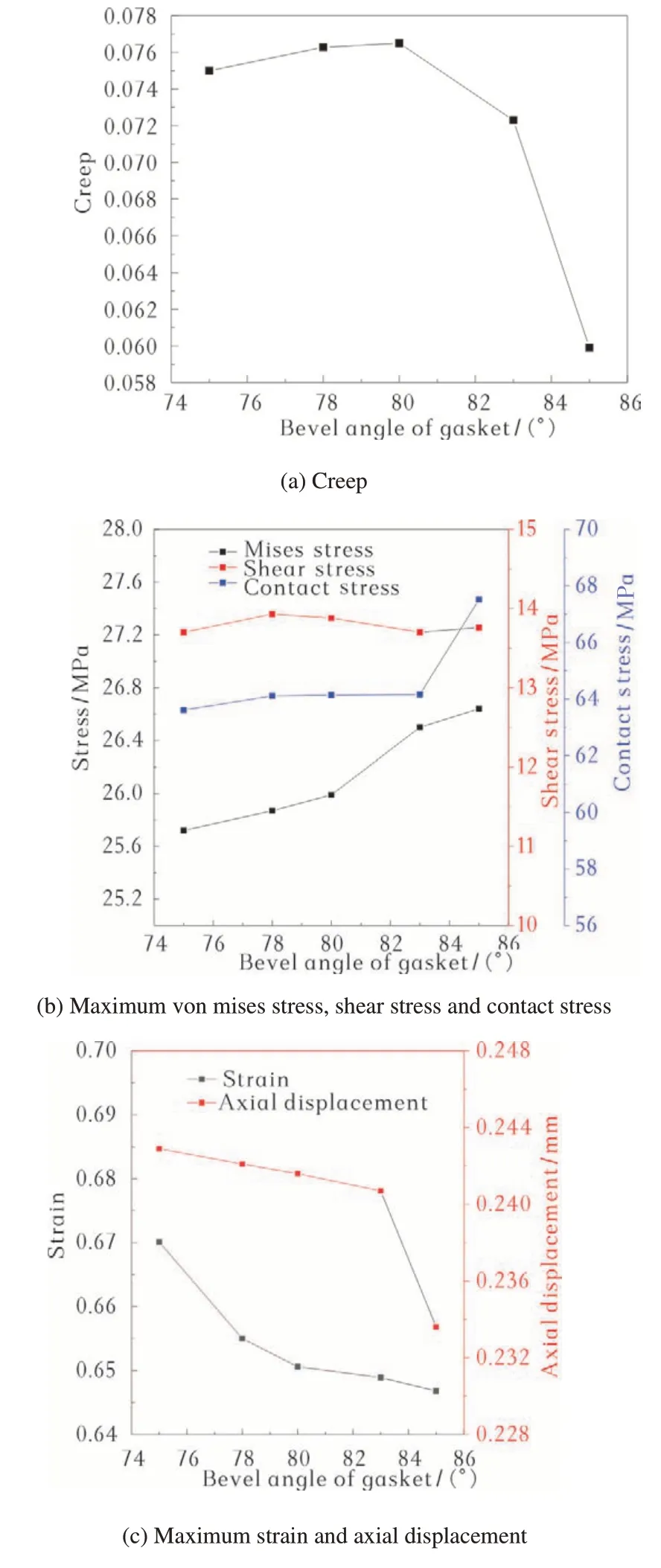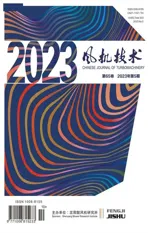Study on the Sealing Performance of Non-metallic Gaskets for Aero-engine Valves Considering Creep Behavior*
2023-11-30LijingLiuRaoZhengShuangxiLiYeLiTanZhaoZeshengHuang
Li-jing Liu Rao Zheng Shuang-xi Li Ye Li Tan Zhao Ze-sheng Huang
(Beijing University of Chemical Technology)
Abstract:The valve gasket for aero-engine is prone to creep under extreme conditions such as high temperature and high pressure.The creep failure of the gasket leads to valve leakage,which seriously threatens the safe and reliable operation of aero-engine.Aiming at the creep failure of FEP gasket in use,a timehardening creep model of valve gasket seal is established.The effects of time,operating pressure,material and structural parameters on the creep and sealing properties of FEP gaskets are analyzed.The results show that the compression rebound rate of gaskets decreases with the increase of time,and small compression rebound rate will decrease the sealing performance.The creep behavior of FEP gasket increases with the increase of operating pressure.Reducing the fillet radius can reduce the probability of shear failure,but also reduce the contact stress.Increasing the height of the boss can reduce the deformation behavior of the gasket,but reduce the contact stress on the sealing surface.When the gasket bevel angle is 85°,the creep property and contact stress of the gasket are higher than those of other sizes.But large bevel angle leads to the gasket unsticking.Replacing the FEP material with the polyimide material can improve the creep resistance of gaskets and the contact stress of sealing surface.Considering the service life and sealing effect of gasket,the material is replaced with polyimide plastic,thefilletradius is0.20mm,the bevelangleis 85°andthe boss heightis 0.2mm.
Keywords:Creep;Sealing Performance;Non-metallicGasket
1 Introduction
Aero-engine valves often face the harsh working conditions of ultra-low and ultra-high pressure,and their sealing performance directly affects the safe and reliable operation of aviation equipment.Aero-engine valves often use non-metallic gaskets as their main seals.Compared with metal gaskets,they have lower hardness and better elastoplastic deformation ability,and are prone to plastic deformation to fill the tiny channel between contact surfaces to ensure that the sealing medium is impervious to leakage [1].However,non-metallic gaskets for aviation engines have extremely high requirements for dimensional accuracy,flatness and roughness.The shear resistance and creep resistance of the materials are poor,and creep is easy to occur,which increases the plastic deformation of the sealing gaskets.The contact stress at the sealing surface decreases with the increase of time,and thus the sealing fails.Then the service life of aeroengine and flight safety of spacecraft are seriously affected.
For the simulation of material creep behavior,we often use Maxwell model,Kelvin model,Burgers model and other linear viscoelastic models,but these constitutive models are often limited [2].The research on nonmetallic viscoelastic materials has made great progress in recent years.Hanyga[3],Gao Qing et al.[4]studied the multiple integral constitutive model of materials.However,due to the complex stress and strain relations of the multiple integral constitutive equation,we could not directly determine the parameters of the constitutive model from the test,and it is difficult to be applied in engineering.The power law relational constitutive relation is simple in form and convenient in numerical implementation,and is widely used in conditions with small creep deformation range[5].Du Peng et al.[6]summarized the domestic performance evaluation methods of non-metallic gaskets,which mainly measured the tensile strength,compressive resilience and creep relaxation property of gaskets through tests.However,the conventional creep relaxation property test time is short,which is difficult to truly reflect the long-term service performance of sealing components.
Therefore,we establish the finite element model of the creep of the valve gasket seal structure by using ABAQUS software based on the mechanical and compressive creep performance tests of materials in this paper.We calculate the creep performance of the seal structure under different pressures for a long time and explore the influence of different structural sizes on the gasket seal performance.This study is of great significance for improving the sealing performance of non-metallic seals,increasing the service life of valves and improving the operational reliability of aerospace vehicles.
2 Finite Element Model for Creep Analysis of Valve Core
2.1 Geometric Model
The sealing structure of the valve core is mainly composed of three parts: the main valve core,the gasket and the valve body.We place the gasket in the sealing slot of the main valve core by bonding method.We simplify the seal into a two-dimensional axisymmetric model,as shown in Fig.1.The simplified model retains the complete shape of the key gasket and omits other components,greatly reducing the calculation time and improving the calculation efficiency.

Fig.1 Valve seal structure and dimensions
2.2 Numerical Analysis Method of Gasket Creep
2.2.1 Creep Mechanism
Creep refers to the phenomenon that the strain of a material increases with time under the condition of constant stress.The typical time-hardening creep curve is shown in Fig.2 below.We divide the creep phenomenon of materials into three stages: decelerating creep,constant velocity creep and accelerating creep.In the working process of the gasket,the material has usually been fractured and other damages during the accelerated creep stage[7],and it takes hundreds or even thousands of hours for the accelerated creep stage to occur.Considering the time cost and the limitation of testing instruments,the accelerated creep stage is temporarily ignored here,and only the creep models of the first two stages are calculated[8].

Fig.2 Typical creep curves
The Norton power law constitutive model is simple in form and convenient in numerical implementation,and is widely used in engineering practice[5].Suitable for the content of this study,the formula is as follows:
In the formula,εcis the creep,Ais the temperature dependent material constant,nis the Norton stress index andmis the constant.
2.2.2 Material Parameters
In order to obtain FEP[9]creep parameters of gasket material,we carry out the static compression creep test on the material using the CMT4504G creep testing machine,and the typical time hardening is adopted by the curve fitting tool included in origin[7].We fit the creep formula,and the fitting results and related material parameters are shown in Tab.1.

Tab.1 Relevant parameters of FEP material
We use the fitting material parameters to simulate the static compression creep test process of FEP material.The comparison between the simulation results and the test results is shown in Fig.3.The calculated results are basically consistent with the test results,and the error rate is less than 10%,so more accurate creep parameters were obtained.

Fig.3 Comparison of static compression creep test and simulation results of FEP material

Fig.4 Applied load and displacement constraints
2.3 Boundaries,Loads,and Mesh
In the finite element calculation of structural mechanics,contact problems are often encountered.Contact occurs between the surfaces of two objects,resulting in the interaction of friction and pressure.The contact settings are shown inTab.2.

Tab.2 Contact attribute setting
The boundary conditions are set as follows: (1) The valve body is set to a fixed constraint,not to move and turn;(2) Prohibit the movement of the main valve core in the direction of theRaxis and allow it to move along the direction of theZaxis;(3)Apply fluid pressurePas shown in the figure;(4)Set the creep time to 10 days[10].
In finite element calculation,mesh division affects the convergence and accuracy of the calculation results[11].In general,the two surface meshes that touch each other are ensured to be fine enough,so the specific situation after partitioning is shown in Fig.5.We use CAX4R mesh for the valve body and valve core,and the mesh density is 0.1mm.The gasket is of CAX4H type due to the soft material,and the mesh of the contact surface is encrypted to 0.03mm to prevent penetration[12].The total number of meshes is 17987.The grid independence verification has been verified by this model and will not be repeated here.

Fig.5 Mesh partitioning and refinement

Fig.6 LE,creep,von mises,shear stress,contact stress before and after creep
2.4 Analysis and Verification of Calculation Results
2.4.1 Analysis of calculation results
We use the finite element software to simulate and analyze the above models,and we obtain the changes of deformation nephogram,Von Mises stress nephogram,shear stress nephogram,contact stress nephogram and creep nephogram with time.It can be seen that the stress,strain and creep on the gasket are all affected by time.Under the condition of constant applied load,the gasket strain increases with time,which is a manifestation of the viscoelasticity of FEP materials.The maximum creep occurs at the left and right sides of the groove,because the stress is the largest here.According to the formula,the greater the stress is,the greater the corresponding creep is.The calculated results conform to the Norton power law constitutive model.The maximum Von Mises stress decreases from 73.90MPa to 52.39MPa with the increase of time,which is the manifestation of stress relaxation in materials.As shown in Fig.7,the contact stress decreases rapidly in a short period of time and slows down after more than ten hours,reflecting the first and second stages of the typical creep curve.

Fig.7 Stress changes over time
Contact stress is an important parameter to measure whether the medium leaks.When the contact stress is less than the fluid pressure,the medium will leak[13] .The contact stress shown in Fig.7 shows a decreasing trend over time,and it can be inferred that if time is long enough,the contact pressure eventually becomes less than the fluid pressure and leads to valve leakage,which is the root cause of valve leakage.
1.4.2 Verification of calculation results
We obtained the variation of the axial displacement of the core with the loading force,which is compared with the test results as shown in Fig.8.It can be seen that the experimental results are basically consistent with the numerical simulation results.The error is very small,indicating the correctness of the numerical simulation method used in this model.

Fig.8 Comparative analysis of numerical simulation and experimental results
3 Analysis of the Factors Affecting the Sealing Performance of Valve Core
The stress relaxation of gasket material leads to the continuous reduction of contact stress,which is the root cause of valve leakage.Therefore,this paper mainly analyzes the influence of the creep phenomenon of gasket on the sealing performance.The creep is mainly affected by time,temperature,external load,structure size,etc[7].Limited by test conditions,this section mainly explores the influence of time,operating pressure,structure size and material on the creep and sealing performance of the gasket.
3.1 Time
In order to explore the influence of time factor on creep and sealing performance,we apply fluid pressure and creep time in the first two steps of Abaqus,and fluid pressure is removed in the last step to explore the resilience of gaskets.As shown in Fig.9 (a) (b),the curve of stress and strain with time shows the creep and stress relaxation properties of the gasket.With the increase of time,the stress on the gasket decreases continuously,that is,the stress relaxation.The maximum stress and strain on the gasket change obviously in the first ten hours,which is the deceleration creep stage.The change rates of stress and strain gradually decrease and then transition to the constant speed creep stage.In this stage,the change rates of stress and strain significantly slow down,and the stress-strain values hardly change any more,reflecting the typical creep law.

Fig.9 Creep relaxation behavior of gasket with creep time
3.2 Operating Pressure
Other parameters remain unchanged.Set the operating pressure to 5~40MPa.As shown in Fig.10(a)~(c),when the operating pressure is lower than 15MPa,the shim creep and mises stress increase with the increase of operating pressure,and when the operating pressure is lower than 10MPa,the shear stress and contact stress increase with the increase of operating pressure.Among them,the stress-strain increases with the increase of operating pressure,which is an obvious result.And the creep increases with the increase of operating pressure.Norton formula shows that the stress indexnis greater than 1,the strain of gasket will increase with the increase of stress,and the creep will therefore increase.Judging the reason from the molecular point of view,the stress will reduce the activation energy of bond cracking,so that the molecular chain is easier to move,with the increase of stress,the molecular chain movement speed is accelerated,the creep deformation is increased[14].

Fig.10 Mechanical behavior of gaskets under different operating pressures

Fig.11 Creep curve of two kinds of material gaskets under the same working pressure

Fig.12 Boss height diagram
However,the parameters such as creep and Mises stress decrease when the operating pressure exceeded 15MPa.In order to judge the cause of this phenomenon,we extract the nephogram of contact stress at operating pressures of 10MPa and 30MPa,as shown in Fig.10(d).Through comparative analysis,the contact between the boss and the main valve core at 40MPa results in collision and extrusion,and the stress generated between the two results in the reduction of the stress and deformation on the gasket and the contact stress on the sealing surface.The boss structure reduces the shape variable of the gasket,which enhances its lasting resilience under high pressure working condition,but also reduces the contact stress between the sealing surface and weakens its sealing effect.
3.3 Gasket Materials
In order to investigate the effect of gasket material on sealing performance,we select the polyimide with good creep resistance[15] to compare the material FEP.As shown in Tab.3,although the von mises stress on the polyimide is greater under the same conditions,the maximum axial displacement is reduced from 0.167mm to 0.055mm and the maximum strain is reduced from 0.24 to 0.030.And the contact stress increases from 60.0MPa to 200.0MPa.The contact stress is the key factor to ensure that the valve does not leak.The increasing of the contact stress significantly improves the sealing ability of the gasket,and the anti-creep deformation ability of the polyimidecanguaranteetheservicelifeofthe gasket.

Tab.3 Mechanical properties of FEP gasket and polyimide gasket
3.4 Geometric Structure of Valve Core
1)Boss height
As above,the boss heighthof the valve body has no effect on the creep and sealing performance of the gasket under medium and low pressure conditions.Therefore,we explore the influence of boss height on the performance of the gasket under pressure of 30MPa,as shown in Fig.13.

Fig.13 Mechanical behavior of gaskets under different boss height

Fig.14 Gasket bevel angle

Fig.15 Mechanical behavior with the bevel angle of gasket after creep

Fig.16 Fillet radius diagram
The maximum strain,axial displacement,mises stress,shear stress and maximum contact stress on the gasket decreased with the increase of boss height.Although increasing the height of the boss can reduce the deformation behavior of the gasket and reduce its internal stress,the values of strain,axial displacement,mises stress and shear stress are not sensitive to the change of the height of the boss,and the decrease of the contact stress due to the increase of the height of the boss will lead to the decrease of the sealing performance of the gasket and affect the service life of the valve.Therefore,the height of the boss is not appropriate to be too high,and the author recommends that the height of the boss be selected within 0.2mm.
2)Gasket bevel Angle
As shown in the figure,take the angle between the bevel of the gasket and the ground(hereinafter referred to as bevel) as α=75°,78°,80°,83°,85°.In order to avoid the influence of boss height on the bevel of the gasket,load the pressure to 15MPa and keep the pressure for 100 days.
As Fig.17,the creep of gasket increases and then decreases with the increase of gasket bevel angle.The creep increases slowly before 80°and then decreases rapidly,indicating that increasing the bevel angle of gasket is conducive to slowing down the creep behavior of gasket.In addition,the maximum strain and axial displacement on the gasket decrease with the increase of the bevel angle,and the maximum mises stress increases with the bevel angle,and the shear stress is not sensitive to this parameter.The contact stress,the key factor affecting the sealing performance of gasket,almost does not change with the increase of bevel angle before 83°,but the contact stress increases suddenly at 85°,which is conducive to the sealing of valve.We could find that when the bevel angle is 85°,the creep performance and contact stress of the gasket are higher than other sizes,but too large bevel angle will cause the gasket to unstick,so the bevel angle of the gasket should not be too large,and it can be set as 85°.

Fig.17 Mechanical behavior with fillet radius of gasket after creep
3)Fillet radius
With other parameters unchanged,we set the raised fillet radius of the valve body asR=0.15mm,0.175,0.20mm,0.225 and 0.25mm respectively.We also load the pressure to 15MPa and kept for 100 days,and we calculate the mechanical characteristics of the five groups of model structures,as shown in Fig.17.
The maximum creep firstly increases and then decreases with the increase of fillet radius,and a turning point occurs when the radius is 0.225mm.According to the creep cloud and stress change curve of the gasket under different sizes,the reason for the decrease of creep is that the maximum stress position changes from the center of fillet to both sides,and the stress decreases instead of increasing,which results in the decrease of creep.In addition,the maximum mises stress,shear stress and contact stress also increase before 0.225mm,and then decrease,as shown in the figure,the maximum stress diffuses from the center to both sides,and the stress concentration occur on both sides of the circular arc whenR=0.25mm.The maximum strain and axial displacement decrease with the increase of fillet radius,and the strain is almost unchanged after 0.225mm,as shown in the figure,the strain occur from the middle to both sides of the diffusion.
In conclusion,reducing the mises stress and shear stress of the seal is beneficial to reduce the mises stress and shear stress of the seal,which can reduce the probability of shear failure of the seal,but also reduces the contact stress,increases the deformation and cut down the seal effect.Considering its service life and sealing effect,the authors recommend that the radius of fillet should be about 0.20mm.
4 Conclusion
In this paper,based on the creep characteristics of a gasket material used for aeroengine valve,we obtain the creep curve of the material through tests and determine the creep parameters by norton constitutive model.We simulate the creep and sealing performance of the gasket by the agehardening model.The main conclusions are as follows:
1) Due to the poor creep resistance of FEP,the contact stress shows a decreasing trend with the increase of time.If the time is long enough,the contact pressure will eventually be less than the fluid pressure and lead to valve leakage,which is the root cause of valve leakage.
2) The continuous increase of gasket strain with the increase of operating pressure will lead to the deterioration of the compression rebound rate of the gasket.The boss structure can prevent the occurrence of excessive plastic deformation of the gasket and prolong the service life of the gasket,but it will also reduce the contact stress of the sealing surface and weaken its sealing performance.
3) Replacing the gasket material with stronger creep resistance can significantly improve the contact stress of the sealing surface,reduce the deformation and axial displacement of the gasket,and improve the sealing effect of the sealing parts.
4) The sealing performance of the gasket is affected by the geometry of the core.Reducing the fillet radius can reduce the probability of shear failure of the gasket,but it will also reduce the contact stress and weaken the sealing effect;Increasing the height of the boss can reduce the deformation behavior of the gasket,but it will reduce the contact stress on the sealing surface;When the gasket bevel angle is 85°,the creep performance and contact stress of the gasket are higher than other sizes,but too large bevel angle will lead to the gasket unsticking.Considering the service life and sealing effect of gasket comprehensively,the fillet radius of 0.20mm,bevel angle of 85°and boss height of 0.2mm are selected.
